Key takeaways:
- Chronic pain significantly affects both emotional well-being and daily functionality, highlighting the importance of understanding its complex nature.
- Effective pain management strategies, including physical therapy, mindfulness, lifestyle adjustments, and community support, can greatly enhance quality of life.
- Personalized approaches, such as keeping a pain journal and experimenting with various activities, can help identify triggers and improve pain management.
- Accessing resources like support groups, educational workshops, and online tools can provide valuable information and emotional support for those dealing with chronic pain.
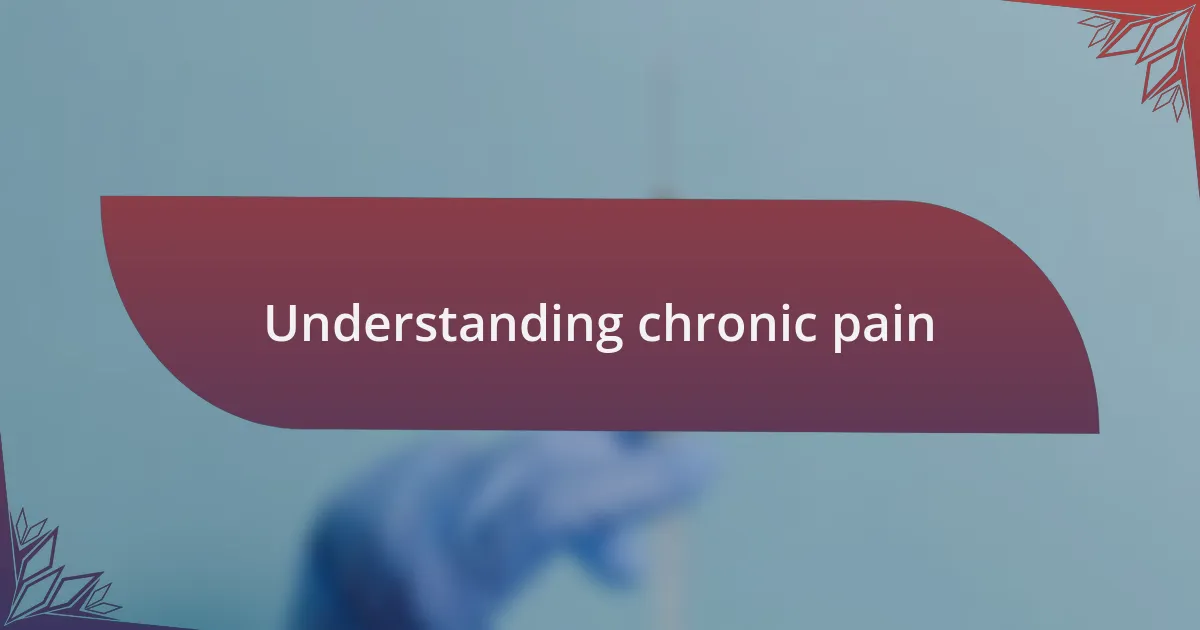
Understanding chronic pain
Chronic pain is often misunderstood, as it extends beyond mere physical discomfort. I remember a time when I believed pain was just a physical ailment to be treated with medication, not realizing how deeply it could impact emotional well-being. Have you ever felt like your body was betraying you, where pain overshadowed even the simplest joys?
Living with chronic pain can feel isolating, but it’s important to recognize that many share this experience. For me, the days when I couldn’t partake in activities I loved left a sense of grief that was hard to articulate. How do we navigate our lives when every movement feels like a reminder of our limitations?
Understanding chronic pain also means recognizing its complex nature. It can flare without warning, often challenging our mental resilience. I often find myself questioning, “How do I push through today?” It’s a testament to our strength when we realize that acknowledging our pain can be the first step toward finding effective management strategies.
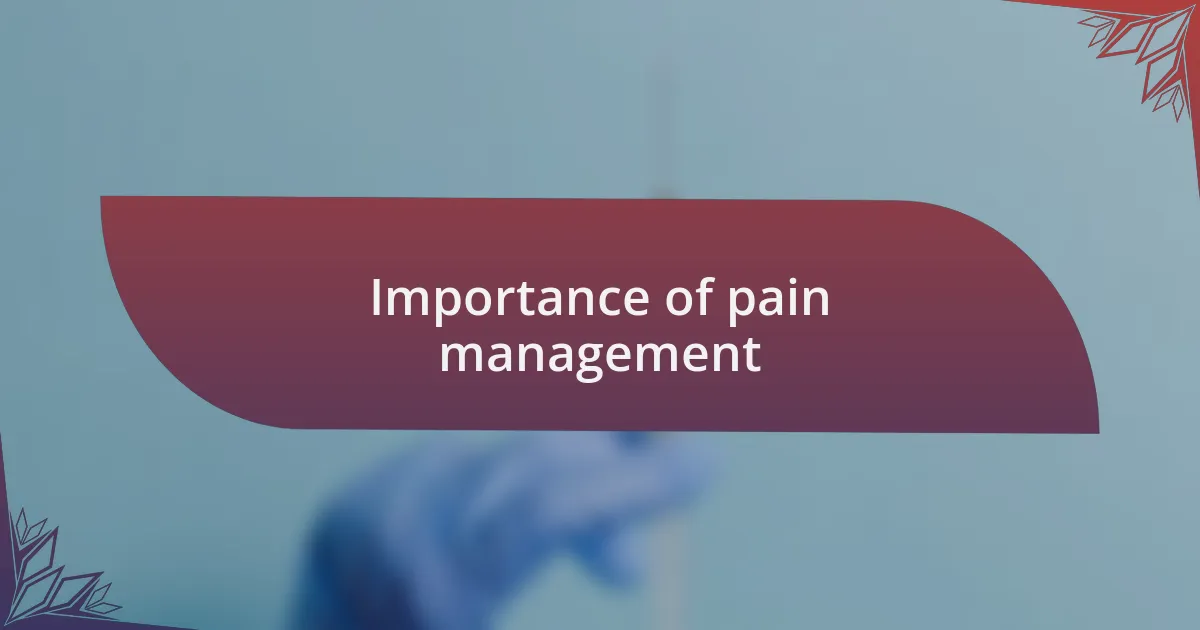
Importance of pain management
Managing chronic pain is essential, as it directly influences not only the physical aspect of our lives but also our mental health and overall quality of life. I’ve seen firsthand how ineffective pain management can lead to a downward spiral, where pain begins to dictate your every thought and action. Have you ever felt so overwhelmed that just getting out of bed seemed like an insurmountable challenge?
Moreover, effective pain management can foster a sense of control over one’s life. There was a period when I experimented with different strategies—including physical therapy and mindfulness techniques—that transformed my daily routine. Each small victory, like walking without a sudden jolt of pain, reminded me that I could still engage with the world around me.
Ultimately, acknowledging the importance of pain management allows us to take proactive steps towards improvement. I often reflect on how the simple act of sharing my experiences with others who understand has been a vital element in my own journey. Don’t you think that connecting with a community can significantly enhance our coping mechanisms?
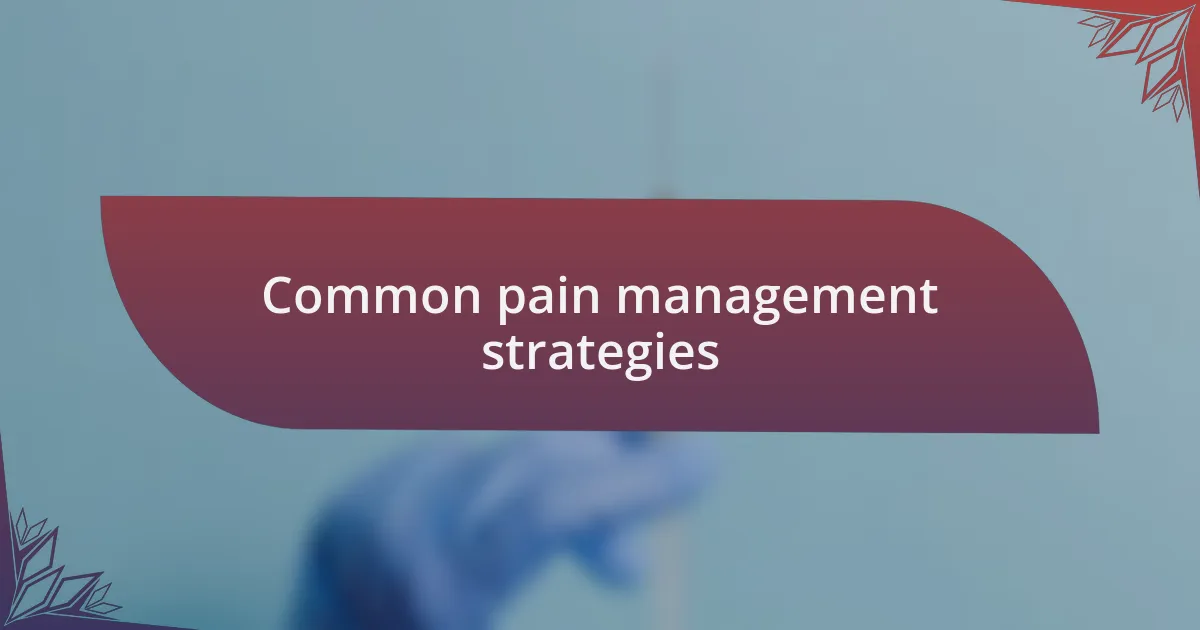
Common pain management strategies
Pain management strategies can vary widely, but I have found that a combination of methods often works best. For instance, integrating physical therapies like yoga or pilates has not only helped me build strength but also improved my flexibility. Have you ever noticed how a simple stretch after sitting for long periods can bring such relief?
Medication is another common approach, but it’s crucial to use it wisely. During a particularly tough time, I relied on over-the-counter pain relievers, but I learned that these should be a supplement, not a crutch. I began to understand the importance of listening to my body and recognizing when to seek professional advice.
Additionally, I discovered the power of lifestyle changes, like diet and sleep hygiene, in managing my pain. When I started paying attention to what I was eating and ensuring I got enough rest, I noticed a marked improvement in my pain levels. Have you ever considered how your daily habits might be influencing your discomfort? Sometimes, it’s these subtle shifts that can make the most significant difference.
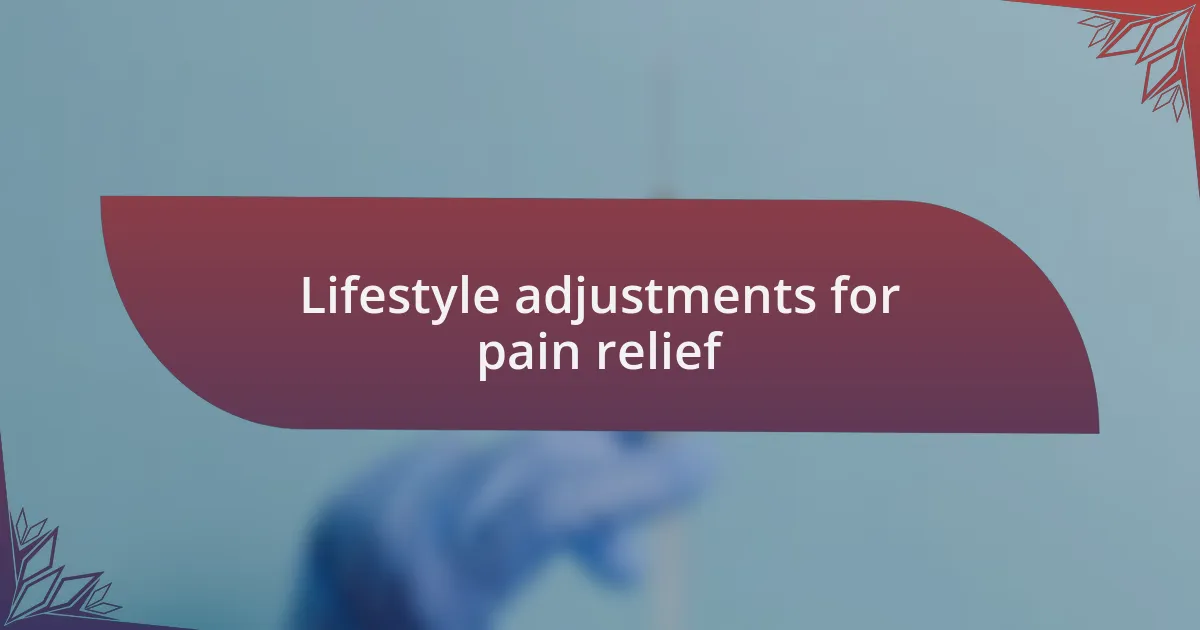
Lifestyle adjustments for pain relief
Making small adjustments in your daily routine can have a profound impact on pain management. For instance, I started setting reminders to take short breaks throughout my day, especially when working at my desk. It’s amazing how stepping away for just five minutes to walk around or stretch can rejuvenate both my body and mind. Have you tried implementing short breaks? It’s like giving your body a chance to reset.
I also shifted my approach to nutrition, opting for anti-inflammatory foods like leafy greens and fatty fish. After making this change, I noticed that certain foods, like processed snacks, seemed to worsen my discomfort. It felt empowering to take control through my diet. Have you ever thought about how your meals might be affecting your pain levels? What we consume can be much more significant than we often realize.
Sleep hygiene became another crucial part of my lifestyle adjustments. I established a calming bedtime routine, which included turning off screens an hour before sleep and enjoying a good book instead. This simple practice not only improved my sleep quality but also significantly reduced my morning stiffness. If you struggle with sleep, what steps are you willing to take for better rest? I find that prioritizing sleep is not just about avoiding pain; it’s also about embracing overall well-being.
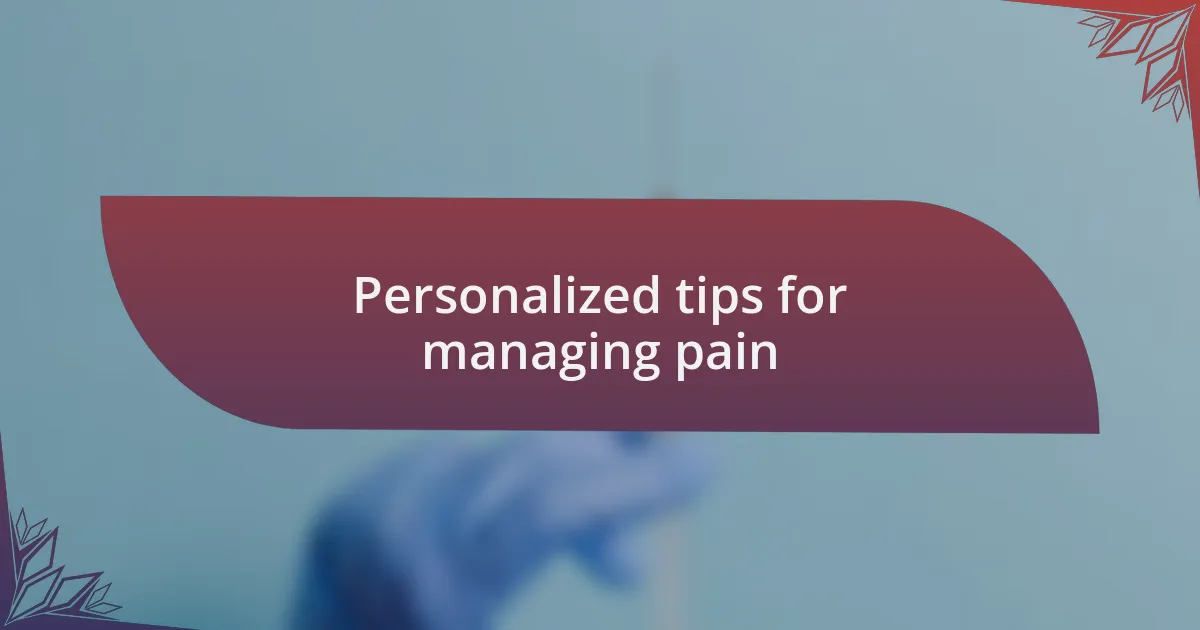
Personalized tips for managing pain
Finding personalized strategies for managing chronic pain can be a game changer. For me, keeping a pain journal was particularly enlightening. By jotting down when my pain flared up, I started to identify specific triggers—like certain weather patterns or activities. Have you ever considered the power of tracking your pain? It might reveal insights that could help you avoid aggravating factors.
In addition to journaling, I discovered the value of mindfulness practices. I often sit quietly for a few minutes, focusing on my breath and letting my thoughts drift. It helps me feel grounded and reduces stress, which I believe plays a big role in how I experience pain. Have you tried meditation or deep breathing? Sometimes, the simplest techniques can make a noticeable difference.
Another tip that has worked wonders for me is experimenting with different forms of physical activity. For instance, I didn’t think yoga would suit me, but I gave it a shot and was pleasantly surprised. The gentle stretching and focus on body awareness helped alleviate some of my pain. What activities bring you joy? Finding movement that feels good can transform your relationship with pain.
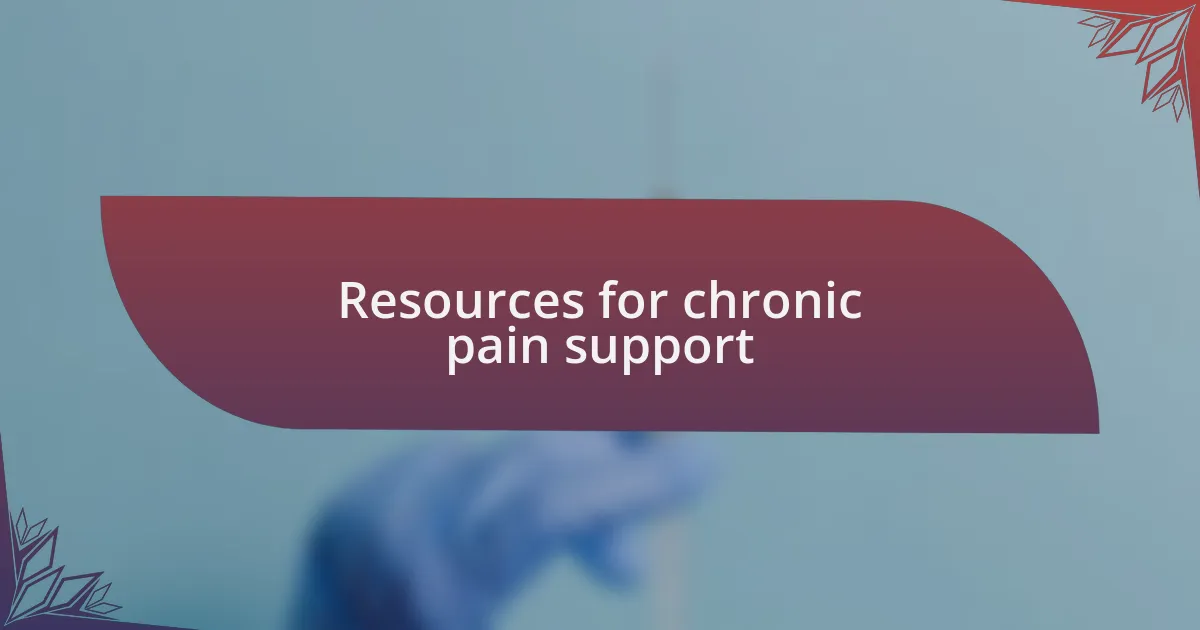
Resources for chronic pain support
When managing chronic pain, accessing reliable resources can make all the difference. I remember the first time I discovered a local support group; it felt like finding a home filled with understanding. Sharing my experiences with others who truly got it was both liberating and comforting. Have you considered looking for online forums or local meetups? These can be great spaces for exchanging tips and emotional support.
Another resource that I found invaluable was educational workshops, specifically those focusing on pain management techniques. I attended a session led by a physical therapist who introduced me to adaptive exercises that I never knew existed. The knowledge I gained made me realize I didn’t have to be a prisoner to my pain. It’s fascinating how learning about your condition can empower you, don’t you think?
Finally, I often turn to online platforms that offer structured programs for chronic pain management. Websites dedicated to health have extensive libraries of articles and videos where experts share the latest research and coping strategies. It’s like having your own personal coach at your fingertips! Have you explored any webinars or podcasts that resonate with your journey? I find the insights shared through these mediums can inspire and motivate me to keep pushing forward.